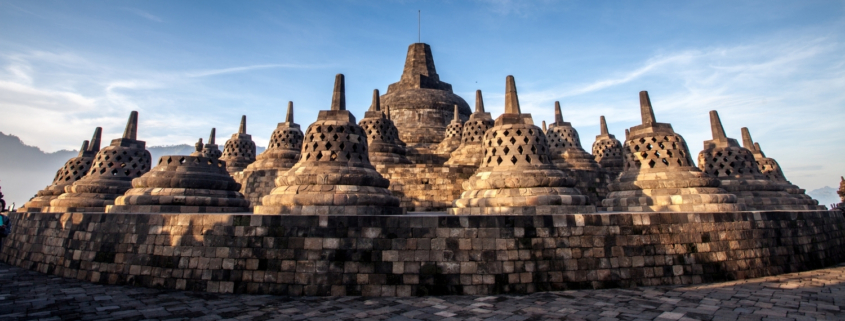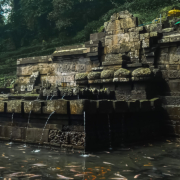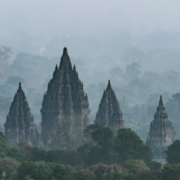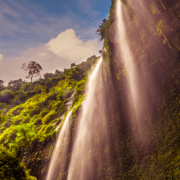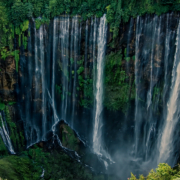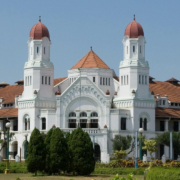Borobudur Temple: A Timeless Monument of Sacred Majesty
Nestled in the heart of Central Java, Indonesia, Borobudur Temple stands as one of the most magnificent and enigmatic spiritual monuments in the world. Constructed in the 9th century during the reign of the Syailendra Dynasty, it remains the largest Buddhist temple on Earth and a UNESCO World Heritage Site. More than just an architectural marvel, Borobudur is a multidimensional mandala, encoded with profound cosmic symbolism, spiritual teachings, and sacred geometry that continues to inspire seekers, historians, and pilgrims alike.
Historical Overview
Borobudur was built around 800 AD under King Samaratungga, during a golden age of Javanese culture where Indian Mahayana Buddhism and local animist traditions harmonized. Its name is believed to derive from “Bhumisambharabhudara,” which means “The Mountain of the Accumulation of Virtues in the Ten Stages of Bodhisattvahood.” Forgotten for centuries under layers of volcanic ash and jungle overgrowth, the temple was rediscovered in 1814 by Sir Thomas Stamford Raffles and painstakingly restored over the years with the help of UNESCO and the Indonesian government.
Architectural Design
Borobudur is an architectural and metaphysical masterpiece, constructed entirely from andesite stone with no use of cement or mortar. Its unique design features a three-tiered structure symbolizing the path to enlightenment:
- Kamadhatu (the World of Desires): The base level, depicting scenes of earthly desire and karmic law.
- Rupadhatu (the World of Forms): The middle terraces, illustrating the life and teachings of the Buddha through intricate bas-reliefs.
- Arupadhatu (the World of the Formless): The top circular platforms, representing pure consciousness, where 72 perforated stupas encircle a grand central stupa—symbolizing Nirvana.
There are 2,672 relief panels and 504 Buddha statues carved into the temple’s structure, making it the largest and most complete ensemble of Buddhist reliefs in the world.
Spiritual Significance
Borobudur is not just a monument—it is a spiritual map for enlightenment. Pilgrims traditionally circumambulate each level in a clockwise direction (pradakshina), moving from the base to the summit in a symbolic journey of awakening. Each level ascended represents a deeper state of purification and detachment, aligning the pilgrim with the sacred dharma encoded in the stone reliefs.
The journey culminates at the highest stupa, empty and open to the sky, reflecting the void-nature of ultimate truth (Shunyata) and the formlessness of the enlightened mind.
Symbolism and Mysticism
- Sacred Geometry: Borobudur is designed as a colossal mandala seen from above, representing the microcosm of the universe and the structure of the enlightened mind.
- Cosmic Mountain: The structure is modeled after Mount Meru, the mythical axis mundi in Buddhist, Hindu, and Jain cosmology.
- Numerological Harmony: The repetition of 72 stupas on the upper terraces is not arbitrary—it reflects sacred mathematical principles believed to channel divine harmony.
Each stone block, every relief, and the alignment of the temple itself is imbued with esoteric meaning, turning Borobudur into a living temple that radiates spiritual energy.
Modern Relevance and Pilgrimage
Today, Borobudur continues to draw visitors from around the world—not only as a major tourist attraction but as a site of spiritual pilgrimage. Thousands gather for the Vesak festival, celebrating the birth, enlightenment, and death of the Buddha with candlelight processions, meditation, and sacred rituals beneath the moonlight.
Spiritual practitioners often report a tangible shift in consciousness when meditating at Borobudur, as if the temple itself is a vibrational portal awakening dormant spiritual codes within the soul.
Travel Tips
- Location: Magelang Regency, Central Java – about 1.5 hours from Yogyakarta.
- Best Time to Visit: Early morning for sunrise at the summit; dry season (May–October) is most recommended.
- Cultural Etiquette: Dress modestly and respectfully, as this is still a sacred site for many Buddhists.
- Extras: Consider hiring a knowledgeable local guide to decode the symbolism in the reliefs.
Borobudur Temple is more than an ancient ruin—it is a temple of time, space, and spirit, encoding the journey of the soul toward enlightenment. It bridges heaven and earth, body and spirit, stone and story. To walk its sacred path is to trace the footsteps of sages and kings, to feel the pulse of an ancient civilization still whispering through the stones.
For any traveler, seeker, or student of the sacred, Borobudur is not just a destination—it is an initiation.

